
Thaddeus Maxim Eugene (Ted) Dikty was an American editor who also played a role as one of the earliest science fiction anthologists, and as a publisher.

Unknown was an American pulp fantasy fiction magazine, published from 1939 to 1943 by Street & Smith, and edited by John W. Campbell. Unknown was a companion to Street & Smith's science fiction pulp, Astounding Science Fiction, which was also edited by Campbell at the time; many authors and illustrators contributed to both magazines. The leading fantasy magazine in the 1930s was Weird Tales, which focused on shock and horror. Campbell wanted to publish a fantasy magazine with more finesse and humor than Weird Tales, and put his plans into action when Eric Frank Russell sent him the manuscript of his novel Sinister Barrier, about aliens who own the human race. Unknown's first issue appeared in March 1939; in addition to Sinister Barrier, it included H. L. Gold's "Trouble With Water", a humorous fantasy about a New Yorker who meets a water gnome. Gold's story was the first of many in Unknown to combine commonplace reality with the fantastic.
The first Golden Age of Science Fiction, often recognized in the United States as the period from 1938 to 1946, was an era during which the science fiction genre gained wide public attention and many classic science fiction stories were published. In the history of science fiction, the Golden Age follows the "pulp era" of the 1920s and 1930s, and precedes New Wave science fiction of the 1960s and 1970s. The 1950s are a transitional period in this scheme; however, Robert Silverberg, who came of age in the 1950s, saw that decade as the true Golden Age.
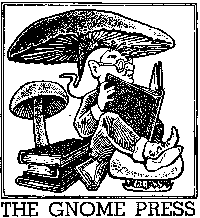
Gnome Press was an American small-press publishing company primarily known for publishing many science fiction classics. Gnome was one of the most eminent of the fan publishers of SF, producing 86 titles in its lifespan — many considered classic works of SF and Fantasy today. Gnome was important in the transitional period between Genre SF as a magazine phenomenon and its arrival in mass-market book publishing, but proved too underfunded to make the leap from fan-based publishing to the professional level. The company existed for just over a decade, ultimately failing due to inability to compete with major publishers who also started to publish science fiction. In its heyday, Gnome published many of the major SF authors, and in some cases, as with Robert E. Howard's Conan series and Isaac Asimov's Foundation series, was responsible for the manner in which their stories were collected into book form.
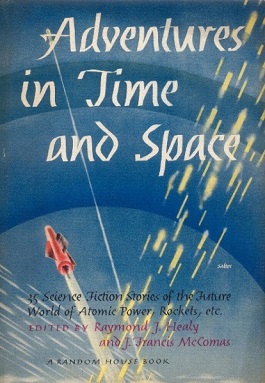
Adventures in Time and Space is an American anthology of science fiction stories edited by Raymond J. Healy and J. Francis McComas and published in 1946 by Random House. A second edition was also published in 1946 that eliminated the last five stories. A Modern Library edition was issued in 1957. When it was re-released in 1975 by Ballantine Books, Analog book reviewer Lester del Rey referred to it as a book he often gave to people in order to turn them onto the genre. It is now once again out of print.
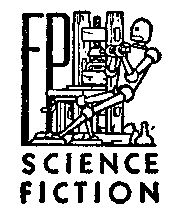
Fantasy Press was an American publishing house specialising in fantasy and science fiction titles. Established in 1946 by Lloyd Arthur Eshbach in Reading, Pennsylvania, it was most notable for publishing the works of authors such as Robert A. Heinlein and E. E. Smith. One of its more notable offerings was the Lensman series.
Everett Franklin Bleiler was an American editor, bibliographer, and scholar of science fiction, detective fiction, and fantasy literature. In the late 1940s and early 1950s, he co-edited the first "year's best" series of science fiction anthologies, and his Checklist of Fantastic Literature has been called "the foundation of modern SF bibliography". Among his other scholarly works are two Hugo Award–nominated volumes concerning early science fiction—Science-Fiction: The Early Years and Science-Fiction: The Gernsback Years—and the massive Guide to Supernatural Fiction.
Advent:Publishers is an American publishing house. It was founded by Earl Kemp and other members of the University of Chicago Science Fiction Club, including Sidney Coleman, in 1955, to publish criticism, history, and bibliography of the science fiction field, beginning with Damon Knight's In Search of Wonder.

The Best Science Fiction Stories: 1949 is a 1949 anthology of science fiction short stories edited by Everett F. Bleiler and T. E. Dikty. It was the first published anthology to present the best science fiction stories for a given year. The stories had originally appeared in 1948 in the magazines Planet Stories, Astounding Science Fiction, Blue Book, Comment, and Thrilling Wonder Stories. The anthology was later combined with the 1950 volume and reissued as Science Fiction Omnibus.
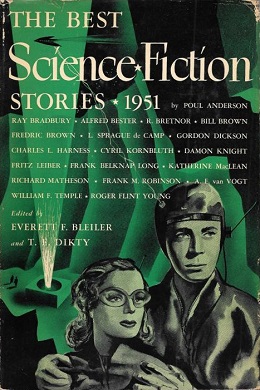
The Best Science Fiction Stories: 1951 is a 1951 anthology of science fiction short stories edited by Everett F. Bleiler and T. E. Dikty. An abridged edition was published in the UK by Grayson in 1952 under the title The Best Science Fiction Stories: Second Series. Most of the stories had originally appeared in 1950 in the magazines Fantasy and Science Fiction, Worlds Beyond, Astounding SF, Other Worlds, Galaxy Science Fiction, Fantastic Story Quarterly, Startling Stories, Collier's Weekly, Thrilling Wonder Stories and Weird Tales.

Men Against the Stars is a 1950 anthology of science fiction short stories edited by Martin Greenberg, originally published in hardcover by Gnome Press. A British hardcover was issued by Grayson & Grayson in 1951. Pyramid Books published several abridged paperback versions in the late 1950s and early 1960s.
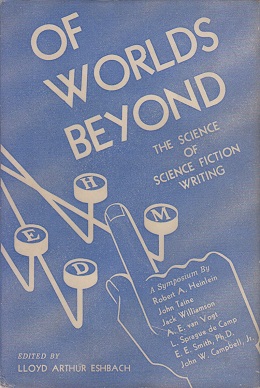
Of Worlds Beyond is a collection of essays about the techniques of writing science fiction, edited by Lloyd Arthur Eshbach. It was first published in 1947 by Fantasy Press in an edition of 1,262 copies. It has been reprinted by Advent in 1964 and by Dobson in 1965.
Grant-Hadley Enterprises was the first of three names used by an American small press publishing house specializing in science fiction titles. The company was founded in 1945 by Donald M. Grant and Thomas G. Hadley and published one title as Grant-Hadley Enterprises. Kenneth J. Krueger joined the company in 1946 and the name was changed to The Buffalo Book Company. Later in 1946, Hadley continued the company on his own as The Hadley Publishing Co.

The Checklist of Fantastic Literature is a bibliography of English science fiction, fantasy and weird books compiled and edited by Everett F. Bleiler with a preface by Melvin Korshak and a cover by Hannes Bok.
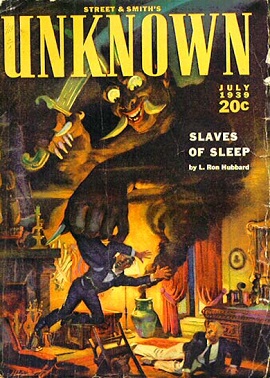
Slaves of Sleep is a science fantasy novel by American writer L. Ron Hubbard. It was first published in book form in 1948 by Shasta Publishers; the novel originally appeared in 1939 in an issue of the magazine Unknown. The novel presents a story in which a man travels to a parallel universe ruled by Ifrits. The protagonist takes on the identity of a human in this dimension, and becomes involved in the politics of Ifrits in this fictional "Arabian Nights" world.

Science Fiction Carnival is an anthology of humorous science fiction stories edited by American writers Fredric Brown and Mack Reynolds. It was published by Shasta Publishers in 1953 in an edition of 3,500 copies. Most of the stories originally appeared in the magazines Super Science Stories, Fantasy and Science Fiction, Astounding, Worlds Beyond, Slant, Imagination, Space Science Fiction, Thrilling Wonder Stories and Blue Book.
Fantasy Publishing Company, Inc., or FPCI, was an American science fiction and fantasy small press specialty publishing company established in 1946. It was the fourth small press company founded by William L. Crawford.

Two Complete Science-Adventure Books was an American pulp science fiction magazine, published by Fiction House, which lasted for eleven issues between 1950 and 1954 as a companion to Planet Stories. Each issue carried two novels or long novellas. It was initially intended to carry only reprints, but soon began to publish original stories. Contributors included Isaac Asimov, Robert A. Heinlein, Arthur C. Clarke, Poul Anderson, John Brunner, and James Blish. The magazine folded in 1954, almost at the end of the pulp era.

Science-fiction and fantasy magazines began to be published in the United States in the 1920s. Stories with science-fiction themes had been appearing for decades in pulp magazines such as Argosy, but there were no magazines that specialized in a single genre until 1915, when Street & Smith, one of the major pulp publishers, brought out Detective Story Magazine. The first magazine to focus solely on fantasy and horror was Weird Tales, which was launched in 1923, and established itself as the leading weird fiction magazine over the next two decades; writers such as H.P. Lovecraft, Clark Ashton Smith and Robert E. Howard became regular contributors. In 1926 Weird Tales was joined by Amazing Stories, published by Hugo Gernsback; Amazing printed only science fiction, and no fantasy. Gernsback included a letter column in Amazing Stories, and this led to the creation of organized science-fiction fandom, as fans contacted each other using the addresses published with the letters. Gernsback wanted the fiction he printed to be scientifically accurate, and educational, as well as entertaining, but found it difficult to obtain stories that met his goals; he printed "The Moon Pool" by Abraham Merritt in 1927, despite it being completely unscientific. Gernsback lost control of Amazing Stories in 1929, but quickly started several new magazines. Wonder Stories, one of Gernsback's titles, was edited by David Lasser, who worked to improve the quality of the fiction he received. Another early competitor was Astounding Stories of Super-Science, which appeared in 1930, edited by Harry Bates, but Bates printed only the most basic adventure stories with minimal scientific content, and little of the material from his era is now remembered.

My Best Science Fiction Story is an anthology of science fiction short stories edited by Leo Margulies and Oscar J. Friend. It was first published in hardcover by Merlin Press in November 1949, and reprinted in August 1950. An abridged paperback edition including twelve of its twenty-five stories was published by Pocket Books in July 1954 and reprinted in November 1955.















